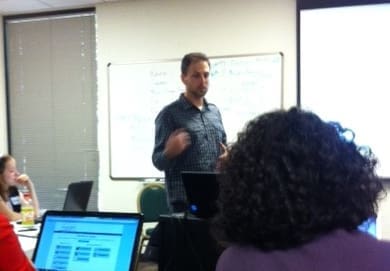Do you market to your customers online as a primary source of demand and lead generation?
All businesses are different. There are entire industries that can exist without a website or extended web presence. But for most of us, we HAVE to market to our customers online. That’s where they are, and where they want to interact with us.

The key is to use a proven approach to messaging and interacting.
There are a myriad of opinions out there about how to do this.
We take a very methodical and pointed approach here at Return On Now.
And we use the same exact methodology on behalf of clients and students of our training sessions.
On June 20, 2013, I presented an Online Marketing Training to the Austin chapter of SCORE on this very topic.
Let’s look at some of the key concepts from that presentation, and then you can find the original slide deck linked at the end of this post for you to review firsthand.
Overarching Messaging: Elevator Pitch
How much time have you spent working up your elevator pitch?
There are several types of elevator pitches, but the most basic kind is that which you will use to compose messaging to prospects and customers.
In the presentation, we looked at what an elevator pitch is and how to build one.
There are tried and true templates for “filling in the blanks” that can help. Our version is included in the PPT linked below.
Customer Lifecycle: Taking Advantage of the Buyer’s Journey
It amazes me to meet business owners and even sales and marketing professionals who overlook the customer lifecycle.
This is a very important concept, and is often mistaken for the “sales funnel” or “lead scoring” process.
Those two processes are focused on a company-centric view of moving prospects through the sales funnel. They are NOT lifecycles.
A customer lifecycle is a psychological model through which prospects travel as they learn who you are, what you do, why they need it, and why you are the best choice.
Like the two aforementioned models, the customer lifecycle culminates in a purchase, but it is customer-centric model for demand generation and lead generation.
The sales funnel and lead scoring methodologies are very useful for sales planning, forecasting, and benchmarking progress in closing deals.
But they are rather useless as tools for composing messaging, planning out assets to use as campaign calls-to-action, or building trusted relationships with potential customers.
Of course, with a concept so important to marketing, there are many different opinions about what should be included in the customer lifecycle.
We included some samples of simple and more complex models, including one “closed loop” model that also incorporates post-sale activities and word of mouth.
For websites, many companies refer to the customer lifecycle as the Buyer’s Journey.
This model is typically a simplified version of the lifecycle, maybe 3-4 stages in length.
It is important to understand the psychological process and also to map out how to speak to all the different stages via a buyer’s journey.
This is important even though the purchase process is no longer linear, thanks to the explosion in popularity for social media and word of mouth influencers.
Web Personas: Composing Content For Real People
Every company with a website should understand the various types or segments of customers they plan to pursue with the site.
A very effective way of improving the way you target these segments is by way of web / buyer personas.
Web personas aim to “personify” a segment of your target audience.
The best examples include a bio, a photograph, and even a real sounding name for the target customer.
When writing content, you write in the tone that would suit the persona you are targeting.
If you have never built personas for your own business, study the samples I shared last week to see how others have done it.
You’ll quickly come to understand how it can help you with your own website messaging.
Reaching Your Customer Online: Tactical Execution Using This Framework
Although we were squeezed for time during the presentation due to a very high level of interactivity (thank you to the participants for keeping it lively), we did a cursory overview of the various online marketing tactics to understand how to apply these concepts in the real world.
Stick with the presentation until the later slides to see more on this topic.
Since we had a short time to cover it, the information is rather shallow, but useful nonetheless.
In the future, we plan to split this material out into two separate trainings.
The first would be most of what you see in the PPT linked below, while the second will be a deeper dive into the tactics.
If you are interested in attending one of these classes in the future, keep an eye on the Workshops & Events page on the Austin SCORE Chapter’s website.
Alternatively, Return On Now also offers custom Internet Marketing and SEO Trainings for businesses of all sizes, as well as SEO consulting and AI-Driven Discoverability (AEO and GEO) services. Contact us directly to learn more.
View the Presentation on Slideshare: How to Market To Your Customers Online…On THEIR Terms
Tommy Landry
Latest posts by Tommy Landry (see all)
- Best Semantic SEO Consultants: Why the Foundation Matters for AEO and GEO - October 28, 2025
- AI-Powered SEO Agents: Why They Fall Short - October 21, 2025
- Law Firm SEO in the AI Era: Why Future-Focused Attorneys Need More Than a Legal SEO Agency - October 16, 2025





